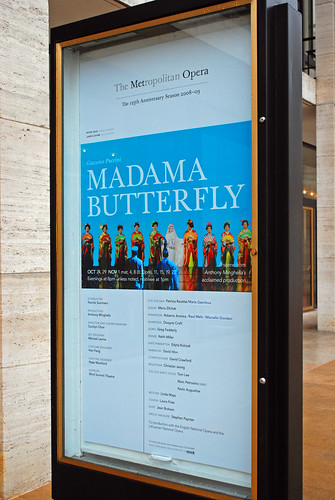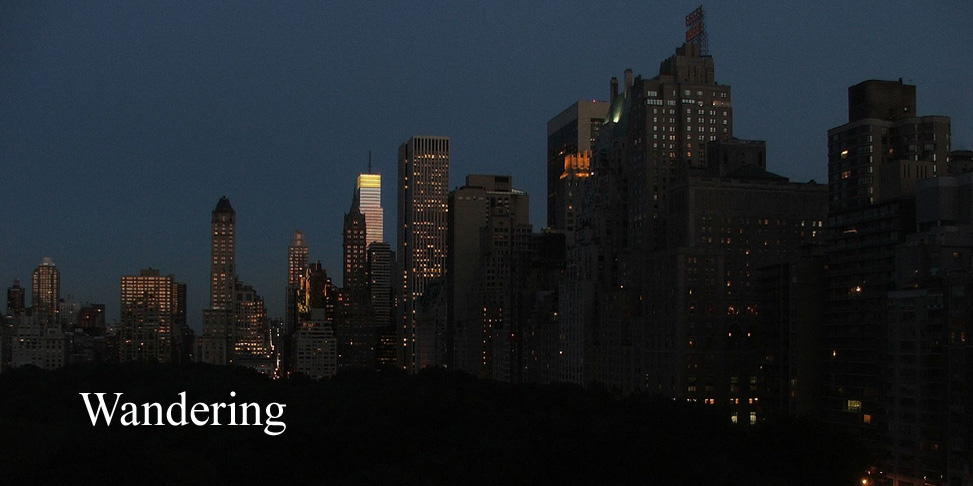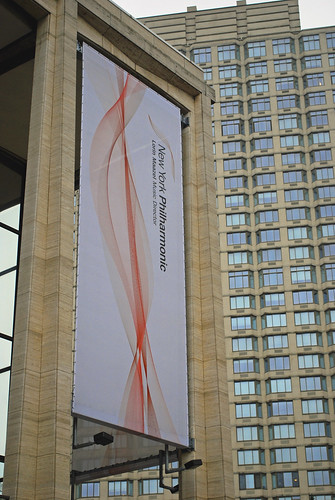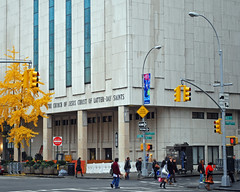
I had dinner with some Met supporters and staff before seeing the last performance for the season of John Adams’s Doctor Atomic. Our tables were separated from the restaurant proper by some bushes in tubs. The Met person told us “John Adams is behind that hedge!” You can’t get any closer to a contemporary opera than that.
There should be a strict rule against recording conversations overheard in theatres and buses and I will follow that rule forever more. But what I overheard prior to Doctor Atomic was very odd and was related to the opera as well.
The main curtain used for Doctor Atomic has a large reproduction of the classic periodic table of elements printed on it. A young couple was seated immediately behind me.
Him: “That’s really interesting: it’s the periodic table….hey … there’s palladium…it’s a very interesting metal.
Her: “What about mercury?”
Him: “I’m not a big fan of mercury.”
“Do you see gold – it’s so malleable and such a great conductor of electricity.”
“I see Chlorine, and Fluorine there - I’m not a big fan of those pharmaceutical elements……”
I am a big fan of Doctor Atomic. I was going to write a lot about it, and may still do so, as it has attracted quite a bit of negative criticism much of it wrongheaded.
I was lucky enough to see the first production of the opera in San Francisco in 2005, and was impressed by it then. Many works need more than one hearing before you can assimilate and begin to understand them. However, I left Doctor Atomic in 2005 with a strong overall impression of the work and distinct memories of two arias: Kitty Oppenheimer’s “Am I in Your Light” and the setting of the Donne sonnet “Batter my Heart” for Oppenheimer himself which ends the first act.
The libretto by Peter Sellars has been criticized as an unwieldy kind of amalgam of miscellaneous poetry and contemporary accounts of the bomb test. I think this overlooks the fact that J. Robert Oppenheimer was himself an exuberant polymath who saw himself in terms of the literature he read. Oppenheimer was recorded as quoting the Donne sonnet for example, and it had some particular biographical associations for him. The references to the Trinity and their relation to the naming of the test site are obvious.
Since its first performance in San Francisco the opera has been seen, in versions of the original production in a number of places, and John Adams has revised it as it has moved from one place to the next, but it’s still very much the same piece. It’s a great tribute to the work that the principal singers who appeared in San Francisco are still in it. Gerald Finley has made the role of Dr. Oppenheimer his own and I agree with Met director Peter Gelb that his is one of the great virtuoso performances of the 21st. century. Eric Owens (General Groves ) and Richard Paul Fink ( Edward Teller ) remain in their original roles.
Peter Sellars was producer in San Francisco and beyond but the Met has commissioned a new production from Penny Woolcock, which is not that different from the original. The last act is still dominated by a hovering reproduction of “the gadget” as the bomb built for testing was known. This production uses what seems to be the new operatic cliché: singers in stacked boxes – but notwithstanding this, I think it achieves greater coherence and intensity. As the opera itself has been changed, it wasn’t clear to me how much of the improvement was to the work itself and how much to the production. For example, a much criticized part of the original was the music, dance and mime performed by Kitty Oppenheimer’s maid Pasqualita and other Native Americans. Pretty clearly, this was intended to contrast the relationship between the New Mexico desert and its longtime inhabitants with the terrible explosion to take place at Los Alamos. This was not incongruous and did not involve wallowing in political correctness either. In the original production however this aspect did seem detached from the main thread and included some less than inspiring dance. Now it is a lot more coherent. Pasqualita was beautifully sung by Meredith Arwady, whom I would describe as a contralto and a deep voice at that; I must investigate why the Met doesn’t recognize “contralto”, it only hears “mezzo sopranos”.
Not everything was better, Kitty Oppenheimer’s movements around the bed during “Am I in Your Light”, caused the action to lose touch with the text.
The Met Orchestra was conducted by Alan Gilbert who will take over the New York Philharmonic next season. There can be no better opera orchestra anywhere, and while the San Francisco orchestra was fine, the playing here was extraordinarily good. Apart from the arias and set pieces, the orchestral score is alive with movement, urgency and anticipation and all of this was perfectly realized.
The Act I finale, the setting of “Batter my heart”, was an intensely moving experience. .Gerald Finley is probably more restrained in his movements than when I first saw him sing it, but this was an amazing and even more powerful performance. John Adams’s setting of the poem has been criticized as insufficiently true to the verse, particularly because of the repetition of some lines. First, this is an opera not a song cycle and the original poem cannot be damaged by the way it is used here. Secondly, any critic should hear Britten’s setting of the poem in his “Holy Sonnets of John Donne” which to me sounds frenetic and superficial by comparison. I think the music here would stand in any context.
The score also includes some electronic music and some poignant spoken Japanese text at the end. This means that there is some amplification. I think the singing or some of it is amplified, but I did not find this troubling. I just don’t like amplified sound in opera. Particularly towards the end there was a repeated motif on a tuba or euphonium, a foreboding of doom I suspect, which was just too loud. Perhaps one day there will be a minimalist version of Atomic without electronics or amplification.












